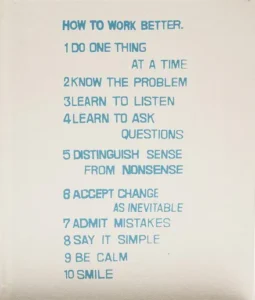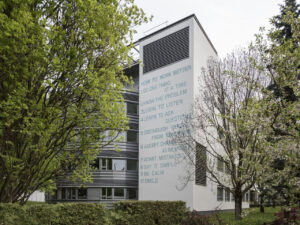
Photo from Sotheby´s
The Artwork
“How to Work Better,” a table of productivity and work habit principles you might have already seen in office frames, on desks, or as postcards, is actually an artwork created by the Swiss artist duo Peter Fischli and David Weiss. This piece was last exhibited on a building facade in Manhattan in 2016 as part of a Guggenheim exhibition celebrating the 33-year artistic partnership.
Its open-ended nature encourages diverse interpretations. By presenting these principles in a public setting, the artwork offers a thought-provoking perspective on work culture and encourages reflection on societal values.
A Critique of Management Language
“How to Work Better” can also be viewed as a critique of the trivial, simplistic, and repetitive nature of management language—such as mission statements and motivational slogans.
These statements often appear similar across companies and are occasionally noted by employees and clients for their disconnect from actual company practices. As a former colleague of mine ironically remarked after interviewing several employees of a client and pointing to the text on the meeting room wall: “These are probably the principles and values of the office decorator”.
Inspiring Reflection and Discussion
Consequently, the artwork inspires reflection at the company level and stimulates discussion among employees, clients, and other stakeholders about the company’s distinct positioning and its effectiveness in fulfilling its promises. It also encourages a reevaluation of one’s approach to work and life.
The Artwork’s Journey: From Zurich to Manhattan, Inspired in Thailand
Originally installed in 1991 as a mural on the facade of an office building in Zurich, visible from the Airport train line, “How to Work Better” has provided daily inspiration to commuters and office workers. The mural continues to resonate with modern audiences as they navigate the balance between self-care and the relentless pace of digital life.

Painted in an Office Building in Oerlikon, North Zurich since 1991 – photo from zuerich.com
The artwork was inspired by a list of rules the artists viewed in a ceramics factory in Thailand. It represents a brilliant rethinking of the readymade—produced objects that are isolated from their intended use and elevated to the status of art through the artist’s choice and designation.
The Artistic Journey of Fischli and Weiss
Peter Fischli (b. 1952) and David Weiss (1946–2012) met in the Zurich punk scene in 1977 and collaborated until Weiss’s death from cancer in 2012. Known for their unique blend of humor, banality, and deep reflections, they pushed seemingly mundane ideas to profound extremes, challenging conventional perspectives with cleverness and irony. Their work often explores the diminishing differences between labor and leisure or work and play, inviting viewers to appreciate the lightness of being without diminishing it. Fischli and Weiss’s oeuvre brilliantly exploits humor to realign our view of the world, making their art both intellectually stimulating and accessible.
* * *
Jose Taboada – Founder of Artcipation | Corporate Strategist
Key Sources: MoMA, zuerich.com
© 2024 Artcipation
Comment Article on:
Do you want to receive more information about this topic?
Subscribe our Mailing List today!

